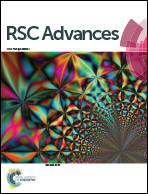Ultrafine graphene oxide–CoFe2O4 nanoparticle composite as T1 and T2 contrast agent for magnetic resonance imaging
Abstract
Graphene oxide–CoFe2O4 nanoparticle composites were synthesized using a two step synthesis method in which graphene oxide was initially synthesized followed by precipitation of CoFe2O4 nanoparticles in a reaction mixture containing graphene oxide. Samples were extracted from the reaction mixture at different times at 80 °C. All the extracted samples contained CoFe2O4 nanoparticles formed over the graphene oxide. It was observed that the increase in the reflux time significantly increased the saturation magnetization value for the superparamagnetic nanoparticles in the composite. It was also noticed that the size of the nanoparticles increased with increase in the reflux time. Transverse relaxivity of the water protons increased monotonically with increase in the reflux time. Whereas, the longitudinal relaxivity value initially increased and then decreased with the reflux time. Graphene oxide–CoFe2O4 nanoparticle composites also exhibit biocompatibility towards the MCF-7 cell line.


 Please wait while we load your content...
Please wait while we load your content...